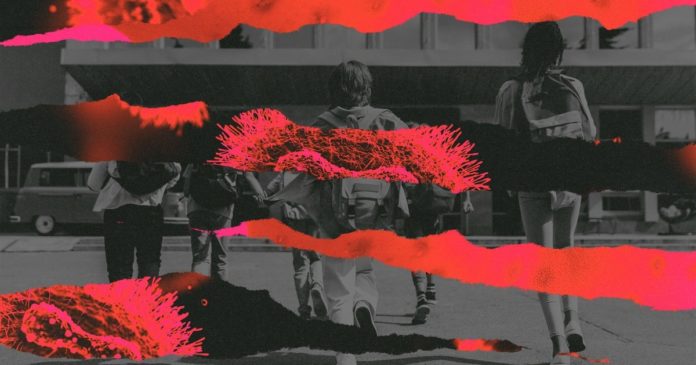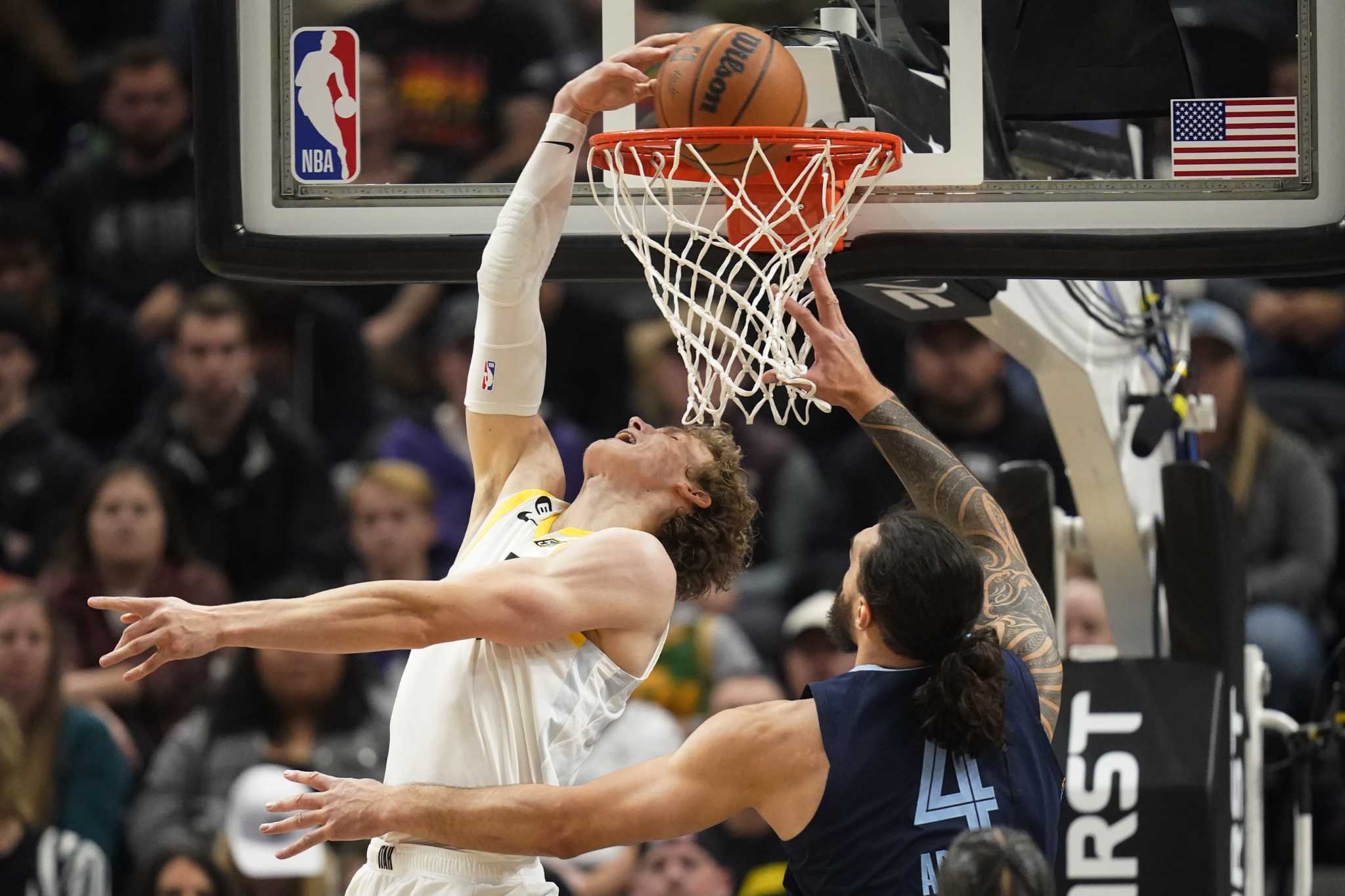:quality(100)/cloudfront-us-east-1.images.arcpublishing.com/thesummit/B7RTKDQX4ZDV5FKNFBBRXWU6DU.jpg)
U.S. students are heading back to school for a third time during the covid pandemic. But this year, public health officials are on the lookout for a second virus, monkeypox. While the virus isn’t currently circulating widely among students, the U.S. leads the world in monkeypox cases, and autumn represents a shake-up of routine that could allow it to spread further.
Experts told Grid that they expect the risk of monkeypox spreading widely within schools to be quite low, with younger kids less vulnerable than high school or college students. Cases will inevitably pop up but in most cases won’t find dense social networks with enough extended skin-to-skin contact to rapidly spread. Certain close-contact activities, like wrestling, might see increased spread. And sexual networks — where the virus is currently spreading — exist in secondary schools and on college campuses.
“I don’t think it’s going to be a major disruptive force,” said Amesh Adalja, an epidemiologist at the Johns Hopkins University Bloomberg School of Public Health. “But schools need to be proactive,” he said, by raising awareness and having plans in place if cases do emerge. And there is always a chance that the virus will behave in surprising ways; its behavior during the current outbreak is much different from in the past, when monkeypox cases popped up in small, self-limiting clusters in parts of Africa.
Since the latest monkeypox outbreak took off in late spring, the virus has spread almost exclusively through the dense social networks of men who have sex with men (MSM), especially people with multiple partners. Anyone who has prolonged skin-to-skin contact with an infected person, and especially with their lesions, can pick up the virus, but the fact that cases have largely stayed within MSM — even as the U.S. racks up more than 18,000 cases — suggests the virus is pretty bad at spreading outside of sex or similarly close contact.
ADVERTISEMENT
“This has been spreading for months, and every day I become a bit more confident that it will remain in the current social network,” said Katelyn Jetelina, a public health researcher and author of the newsletter Your Local Epidemiologist. “The challenge is that behaviors are dramatically changing right now from summer to fall with school starting, so this is a really critical time to pay even closer attention.”
Recent history highlights that viruses do jump between social networks. In 2008, a particular drug-resistant strain of methicillin-resistant Staphylococcus aureus (MRSA) was initially detected mostly among MSM but later popped up in other dense social networks too, like wrestling teams and schools, Jetelina said. MRSA is different from monkeypox, and the strain was likely circulating more widely at the time, but it highlights the importance of being vigilant, she said.
Small outbreaks are possible
Limited evidence suggests that children under 8 who contract monkeypox may face higher odds of severe disease. But so far, only 17 children aged 15 and younger have contracted monkeypox so far in the U.S., according to data from the Centers for Disease Control and Prevention. “These are really coming from household contact settings,” said Peter Chin-Hong, an infectious disease specialist at the University of California, San Francisco. “So likely repeated contact over multiple days or hours.”
Classrooms are often the site of transmission for lots of pathogens because young kids aren’t always attentive to personal hygiene “and can slobber over each other,” said Chin-Hong. Those kinds of messy-but-brief interactions are good for transmitting many pathogens, but not monkeypox, said Chin-Hong. “You really need to have prolonged skin-to-skin contact and repeated exposure,” he said. Recent research suggests that it likely takes a lot of viral particles from a lesion to kick-start an infection. The sorts of brush-ups kids have in class don’t give the virus much time, and clothing provides an additional barrier, he said.
But just because the risk of transmission in school settings is low doesn’t mean it won’t happen.
ADVERTISEMENT
“I would not be surprised at all if there are small outbreaks that occur in day care settings or elementary schools likely coming from household transmission,” said Jay Varma, a physician and epidemiologist who specializes in infectious diseases at Weill Cornell Medical School. “I think it’s very unlikely that there will be outbreaks or sustained transmission in lots of different schools.”
Sports teams may face higher risk
Within schools, there might be networks of closer contact that the monkeypox virus could exploit if it gets introduced. Wrestling teams, which often deal with other skin infections, are likely at higher risk. “If you’re going to mimic the type of skin-to-skin contact monkeypox needs to spread, wrestling would be the closest example,” Varma said. There’s also potential to pick up the virus from shared surfaces, like the wrestling mat or towels.
But the sorts of normal precautions wrestling programs take to limit the spread of other skin diseases could mitigate the risk. “Wrestlers are really attuned to skin infections,” said Adalja, and normal precautions like pre-match screening and mat-cleaning protocols will likely help. “There’s going to be some biological risks there, but I don’t know that it’s going to be one that really materializes that much.”
Gyms might provide more opportunity for the virus to hitch a ride on shared surfaces too, as well as activities that involve shared clothing. “Initially I was concerned about spread in, for example, theater groups, where people share clothes all the time,” said Varma. “But I’m less concerned about that now because we just aren’t hearing about people acquiring this infection through shared materials,” he said. “That doesn’t mean it can’t happen, but it’s a question of likelihood.”
Schools should still be prepared to deal with cases to minimize any chance of spread by developing clearer guidance for students, especially sports teams, on what monkeypox is and how to minimize risks, said Varma. Schools should also have plans in place for facilitating testing through local public health departments.
ADVERTISEMENT
Colleges grapple with risk from sexual activity
Colleges and universities will probably be at higher risk of monkeypox transmission, primarily because there’s more sexual activity among college students, though dormitories could hasten spread too. “We know that the most likely way you’re going to get monkeypox is by being sexually active, right now through gay men’s sexual networks, so I would really be focused on colleges,” said Varma.
College is a time when many students are forging new sexual identities, said Chin-Hong, which could provide the virus with an opportunity to move between different social networks. That could make more targeted efforts to raise awareness among those at highest risk more difficult on campus.
“Old-fashioned awareness and education is going to be the most important thing,” Chin-Hong said, “and doing so in a sensitive way that’s not stigmatizing certain groups but rather destigmatizing recognition and getting people help.”
The American College Health Association is preparing to release guidance for institutions as early as Thursday, said Rachel Mack, director of communications, in an email.
Over two years of operating in a pandemic could give some universities a leg up. “Many college campuses still have an operation standing up for covid that can be repurposed for monkeypox, which is going to be a much lower threat,” said Adalja. In addition to raising awareness, universities should ensure that student health centers can facilitate testing for students who present with symptoms and have vaccines available to students at highest risk as supply improves, he said. Schools also need to plan for how to support students with monkeypox who may need to isolate.
“They should have this all thought out now,” said Adalja, “not when they have one case and parents and students are freaking out.”
Thanks to Lillian Barkley for copy editing this article.







